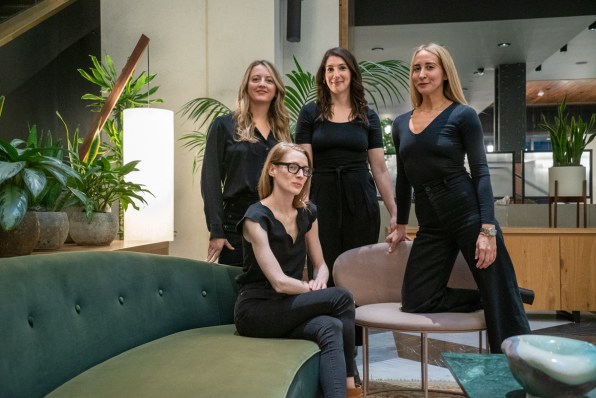Talk about the collection of technologies and ideas known as Web3 often focuses on making up for the transgressions of Web 2.0 companies, which have centralized control over online experiences and mined our personal data for their own profit. Whether or not you think the future of the internet involves AR, VR, NFTs, DAOs, the multiverse, or some combination thereof, there is an immense amount of money flooding into those sectors from the usual suspects. But if the same companies and people who ran Web 2.0 are at the helm of Web3, how much can really change?
At its core, Web3 is about paying creators for their work. Music, artwork, digital fashion—any kind of intellectual property— is turned into or somehow attached to NFTs, so that the work can be certified, tracked, and transacted on a public blockchain. This infrastructure allows creators to be paid directly for their work. In this grand vision, the new internet is decentralized, with no one entity controlling it.
How that will function is still being worked out. And right now, many of the people showing the most excitement about Web3 are the tech bro types you probably envision. But there’s also a cadre of women taking up their pickaxes and heaving them into the fertile new internet. They’re creating incentives to draw more women to Web3, so they can have a say in the next web.
One of the splashiest efforts is BFF, a community that is designed to teach women how to get in on the crypto boom. Only one month old, it is already 14,000 members strong. BFF is led by Brit Morin, a former Googler and the founder of women’s media brand Brit + Co. She cofounded this new community for the “crypto curious” with a list of 50-plus celebrities (Tyra Banks, Gwyneth Paltrow, and Mila Kunis), technologists, and entrepreneurs.
Another group, launched in 2018, is Black Women in Crypto, which aims to welcome more black women into the crypto space. There are also women-focused NFT collections such as Boss Beauties, WomenRise, and Crypto Coven. Some of these concentrate on art pieces, but Crypto Coven is selling avatars for the metaverse, the persistent VR/AR experience that could sit on top of Web3. Increasingly, there is funding for women content creators. Last week, Randi Zuckerberg—an entrepreneur who got her start in tech working for her brother Mark’s company—launched an accelerator called Big Hug that aims to elevate female creators with funding and mentorship.
The timing of these ventures is propitious. In November, art market research firm ArtTactic noted that only 16% of NFT sales were going to female artists (the stats for non-white women were even more dismal). On NiftyGateway, an NFT marketplace owned by the Winklevoss twins, less than 4% of the artworks come from artists in Africa, less than 2.5% comes from Latin America, and less than 1% comes from artists in the Near East, the report says.
IN THE METAVERSE, WE’RE ALL WORLD BUILDERS—NOW IS YOUR TIME TO BUILD.” – CATHY HACKL
On top of that, CEOs in charge of the biggest metaverse platforms so far—Fortnite, Roblox, Sandbox, Decentraland, and Meta—are all white men, though at least two of those companies have a woman in the role of COO. Discord, widely thought to be at the leading edge of social networking, also has a white man at the wheel; however the company has a female head of engineering, Prachi Gupta. In crypto, the landscape is even worse, with only 5% of crypto companies being led by women, according to a recent estimate. Meanwhile, global venture capitalists poured $25 billion into blockchain companies last year, according to CB Insights. Pitchbook reports venture capitalists have also been investing about $2.2 billion per year since 2018 in augmented and virtual reality.
Much of the current effort to bring women onto futuristic internet platforms is as content creators, rather than engineers of the underlying technology. Web3 is in some ways like the early 1990 iteration of the web, free and open to whoever is willing to develop in it. The goal of these various efforts to attract women to these new platforms is to ensure they have the same opportunity to capitalize as men do. It’s becoming clear that in the next version of the online world, having technical skill may be less important than being able to attract a band of devotees.
“I’m a big proponent of saying, in the metaverse we’re all world builders—now is your time to build,” says tech futurist Cathy Hackl. While giving women a chance to build out the next big internet space is undoubtedly important, there is a question as to whether this will necessarily lead to a safer and more inclusive internet for all. Much of that will depend on who controls the technology that content is built on top of.

[Metajuku: courtesy of Everyrealm]
THE ULTIMATE CREATOR ECONOMY
While men still dominate in the nascent metaverse, female creators in Web3 are already rising to the top. Krista Kim is one of the most notable, for selling her digital Mars House for half a million dollars. Natalie Johnson, who spent much of her early career as a fashion buyer, is now building out a digital fashion house called Neuno. Everyrealm, a metaverse company with a majority female leadership team, garnered attention for its million-dollar land grab in Decentraland (the company has since invested $4.2 million into nearly 800 land parcels in The Sandbox).
Janine Yorio, cofounder and CEO of Everyrealm, has a background in private equity and in real estate. After selling her real estate investment app Compound to investment platform Republic, she started speculating on metaverse properties for fun. This gambit quickly became the foundation of Everyrealm, her metaverse investment company. She says one of the most important things to understand about developing in the metaverse and making NFTs is that these products need communities.

[Everyrealm executives from left to right: CEO Janine Yorio, CCO Jacqueline Schmidt, Metaverse and NFT lead Julia Schwartz, CMO Katie Witkin, courtesy of Everyrealm]
“Crypto and the metaverse are so community-focused that you can build the coolest project ever, but if you don’t have a community and if you don’t know how to market it, then it’s worthless,” says Julia Schwartz, cofounder of Everyrealm who leads metaverse and NFT development.
“It’s almost like if you were selling condos on spec: there’s an artist rendering and people are like, okay, I’ll take the penthouse. But then they put their deposit down and every month they’re like, okay, where is it? What’s happening? And so you have to show them mood boards and storyboards and bring them along for the ride— there are a lot of similarities to real world real estate development in that sense.”

[Jonathan Simkhai Metaverse Fashion Week Show: credit Everyrealm, Blueberry, Jonathan Simkha]
Because the metaverse and NFTs are so community-based, many women feel that they have a certain edge over men. “A woman-driven community is definitely a little more chill, a little more supportive,” says serial entrepreneur Gizem Mishi McDuff. “There are good vibes there and then there’s a lot less toxicity, because we care about that so much and that allows for the community to grow a lot faster in a better way.” The beauty of NFTs and a universally accepted blockchain, she argues, is that if a given community no longer suits you, you pick up your digital property and take it to a new one. You’re not chained to any one platform.
McDuff owns a digital fashion company called Blueberry and says she came to virtual worlds almost by accident a decade ago. “There was this musical artist called Skye Galaxy and he did his concerts on Second Life,” she says. “So I ended up downloading Second Life and joining his shows just to see his concerts and I’ve been obsessed ever since.” Pivotally, she met a really cute guy at one of the shows. “The next time I saw him, I wanted my avatar to look cool. So I went shopping a little bit and I installed Photoshop and I made myself a cute little dress and it worked. He’s my husband now.”
This experience was the spark for Blueberry, which designs clothes for Second Life and has 20 million digital assets. More recently, her company put on a runway show in Second Life for Jonathan Simkhai during New York Fashion Week.
One thing McDuff worries about is how the platforms within the metaverse will be run as the ecosystem grows up. “There are a couple of things that are going on that will blow up in our face,” she says. These include how metaverse platforms compensate creators. Roblox, for example, only gives developers on its platform a quarter of every dollar spent, retaining a 75% cut on their creations.
“When there is such a high tax on the content you create, it is not as motivating, so the quality of the content is a little less or the innovation is a little less,” she says. McDuff also believes that the fact that Roblox is profiting from the labor of kids will lead to regulation that slows down the development of the metaverse. “Kids are making this company a ton of money,” she says. (The company reported $1.9 billion in revenue in 2021.)
THE UNLIKELIHOOD OF A DECENTRALIZED WEB
The kids who are developing in Roblox also can’t take what they built with them. Which brings me back to the original question: A diversity of people, including more women, may be developing content and communities on top of Web3 and the metaverse, but does it matter if don’t they own the underlying platforms themselves?
“A platform is only as strong as its infrastructure; if the infrastructure is designed in a biased or non-inclusive way, the ripple effects of that are profound,” says Danah Boyd, a Microsoft researcher and the founder of Data & Society, via email. She’s speaking about technology generally, though this rational could apply to Web3 or the metaverse.
Platform owners wield immense control. Reddit allowed hate speech to flourish on its platform, because its executives prioritized a free speech policy. For years, Facebook allowed misinformation to spread freely to its users. When Twitter was first designed, its originators were not thinking about the potential for harassment and it took the company 15 years to create features to combat toxic behavior on its platform. (Safety Mode is still in beta.) Community moderators play important role in keeping communities safe, but they are ultimately limited or supported by the larger rules of the platforms.
Twitter cofounder and recently-departed CEO Jack Dorsey recently got in trouble with venture capitalist Marc Andreessen for suggesting that Web3 will not be as decentralized as promised. Dorsey tweeted that venture capitalists, who funded the companies that came to own Web 2.0, will also control Web3. He also posits that the web of the future is far more likely to be centralized than decentralized.
Currently, many of the companies working on the next version of the web are building on top of Ethereum, a decentralized blockchain initially created by Canadian programmer Vitaly Dmitriyevich Buterin. While there is a lot of debate about whether Ethereum is truly decentralized, the bigger question is whether big tech companies will develop on a decentralized blockchain. More likely, they’ll create their own blockchain and try and incentivize developers to build on top of it.
THERE’S A BIT OF CONFLICT RIGHT NOW BETWEEN KIND OF THE COMPLETE UTOPIAN DECENTRALIZATION AND THE CENTRALIZED WEB.” – RANDI ZUCKERBERG
Meta (née Facebook) has tried to get its own blockchain going (to no avail). Gaming companies already have their own world specific economies, though players can’t take any of the stuff they build or buy off the platforms. So far, Dorsey’s other company, which rebranded from Square to Block (yes as in Blockchain), is the only outfit working on a blockchain it doesn’t own, by working on decentralized finance apps built on Bitcoin. Even if Ethereum does win out, big tech could still find a way to control it. Amazon’s AWS already runs 25% of Ethereum workloads, giving it outsized impact on the platform.“I agree that there’s a bit of conflict right now between kind of the complete utopian decentralization and the centralized web,” says Randi Zuckerberg. “I don’t think either of those extremes are correct, but I think we’re going to have to figure out where we net out in the middle of complete decentralization and complete centralization.” She notes that being in crypto right now doesn’t feel safe. “You’ve got to have your own back or you’re going to get scammed,” she says. While she doesn’t know exactly how centralization will come into play, she thinks it’s necessary for there to be accountability on the platform.
Zuckerberg says it absolutely matters who is building the underlying technology in Web3 as well as the virtual reality platforms that make up the metaverse. “If you go into Discord communities, I think there is a super strong and immediate difference that you sense in a Discord community where the project has even one woman on the team versus projects that are all crypto bros,” she says. “There’s an immediate difference in what the discussion is like, what they’ll tolerate in those communities, and the mission, the goals and the ethos.”
However the next version of the internet shapes up, it is perhaps promising that more women are deciding what companies get funded. In addition to Randi Zuckerberg, Beryl Li, cofounder of Yield Guild Games, is investing in play-to-earn game companies. At venture capital firm a16z, Arianna Simpson is leading investments in crypto and Web3 (one investment she was involved with is in a woman led company called Iron Fish, which is developing a privacy layer for blockchains). Projects like BFF create even more ways for women to play around with this burgeoning technology.
“In this new era we’re very empowered,” says Hackl of herself and other women. In the last year she’s been invited to invest in several companies: “I’ve never seen myself as an investor, but now I do.”


































